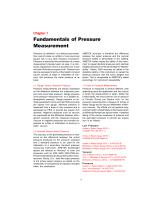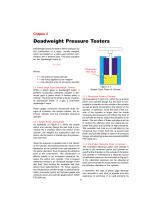 Website:
Ametek STC
Website:
Ametek STC
Group: AMETEK
Catalog excerpts

TEST & CALIBRATION INSTRUMENTS Precision Pressure Measurement User Guide to Pressure Measurement
Open the catalog to page 1
Pressure, by definition, is a derived para-meter. One cannot create an artifact of one pound per square inch or any other measure of pressure. Pressure is derived by the combination of a mass measurement imposed upon an area. It is commonly expressed in terms of pounds force or per unit area (Pounds per square inch). Pressure can also be expressed in terms of the height of a liquid column (Inches of water or millimeters of mercury) that produces the same pressure at its base. 1.1 Gauge Versus Absolute Pressure Pressure measurements are always expressed as the difference between the measured...
Open the catalog to page 4
1.6 Primary and Secondary Pressure Standards 1.4 Units of Mass Measurement The term mass as used in the mathematical expressions for pressure is understood to be the true mass or the mass value that would be measured in a vacuum. Although this is the value required for the pressure equation, many different methods have been used by both deadweight tester manufacturers and calibration facilities. These methods fall into two categories: true mass and apparent mass versus some material of a different stated density. Typical materials and conditions for apparent mass are brass with a density of...
Open the catalog to page 5
Deadweight Pressure Testers Deadweight pressure testers derive pressure by the combination of a mass, usually weights, which are floated on a piston and cylinder combination with a defined area. The basic equation for the deadweight tester is: P = F/A Pressurized Test Fluid Where: P = the pressure being derived F = the force applied by the weights A = the effective area of the piston cylinder Figure 2-1 Simple Type Piston & Cylinder 2.1 Piston Gage Type Deadweight Testers Within a piston gage or deadweight tester, a platform containing calibrated weights is balanced upon a piston which is...
Open the catalog to page 6
Calibration Pressure Pressurized Test Fluid Pressurized Test Fluid Figure 2-2 Reentrant Type Piston & Cylinder Figure 2-3 Controlled Clearance Type Piston & Cylinder standards laboratories such as the National Institute of Standards and Technology (NIST) in the United States. 2.3 Other Types of Piston Gages A vacuum-backed piston gage is designed to measure absolute pressure. This instrument is similar to the conventional piston gage except that both the piston and cylinder and the weights operate within a vacuum evacuated bell jar. The pressure within the evacuated chamber must be measured...
Open the catalog to page 7
Spherical Piston (Ceramic Ball) Weight Carrier Cylinder Core Equalization Annulus Nozzle Body Suspended Weights Dynamic Stabilization System Regulator Capacity Tank Exponential Flow Regulator Test Pressure Connection "Out" Figure 2-4 Schematic Diagram - Floating Ball-type Deadweight Tester 2.4 Intrinsic Correction Terms As described by P.L.M. Heideman and B.E. Welch, United States National Institute of Standards and Technology1, the pressure P generated by a piston gage at its reference level is given by the following equation: The term ( 1 - ρair/ρM ) is the air buoyancy correction for...
Open the catalog to page 8
2.4.3 Surface Tension The term γC describes the force generated by the surface tension of the fluid acting on the piston where it emerges from the fluid. is the surface tension of the fluid and C is the circumference of the piston. The value of Spinesso 38 is representative for many oils used in piston gages. For a piston of 32 mm2 cross sectional area this correction amounts to about 10-4 Newtons. This constitutes a minimal correction at high pressures, but for low pressure oil gages it should always be taken into account. This correction does not apply to air-operated gages. 2.4.4 Tare...
Open the catalog to page 9
2.5.1 Gravity If the local gravity at the test site is different from the gravity for which the deadweight tester was calibrated, the actual pressure as shown on the Calibration Report can be converted to actual pressure at the test site through the use of the following formula: PL = PA x Gl/G Where: PL= Actual Pressure at the local gravity of the test site PA= Actual Pressure as shown in the Calibration Report Gl = Local Gravity in Gals. (cm/sec2) G = Gravity for which the deadweight tester was calibrated in Gals. (cm/sec2) An example of this correction would be a reading of 3000 PSIG,...
Open the catalog to page 10
2.6 Traceability and Uncertainty The parameters of both traceability and uncertainty are concerned with the accuracy of measurement within the laboratory that conducted the testing on the pressure standard. Traceability is a measure of the ability of the laboratory to trace the calibration of a pressure standard through a direct chain of calibrations to a national standards laboratory such as the United States National Institute of Standards and Technology. Uncertainty is an estimate of the measurement accuracy of the traceability chain of calibrations. NIST USA Pressure Standard AMETEK...
Open the catalog to page 11
Currently, equipment specifications and advertisements include only claims on the accuracy of deadweight testers and do not include the uncertainty on the accuracy measurement. The traceability path and uncertainty measurement within the AMETEK Pressure Standards Laboratory as reported are well above industry average. Future efforts on a United States national level including laboratory accreditation (Already in place in Europe and Asia) should require that both the accuracy and uncertainty levels of instruments such as deadweight testers be reported.
Open the catalog to page 12
Deadweight Tester Calibration 3.1.2 Calibrated Characterization of Deadweight Testers The calibrated characterization of deadweight testers involves the transfer of effective areas of one piston and cylinder to another utilizing pressure based cross-float techniques. To use this technique, identical piston and cylinders are placed in identical mountings with the output pressures connected. Means, such as a differential pressure meter are included to identify the time when a pressure balance between the two pressure generating components has been achieved at the reference levels of both the...
Open the catalog to page 13All Ametek STC catalogs and technical brochures
-
XP2i Pressure Gauge psi
5 Pages
-
PTC-125 Cooler
12 Pages
-
MTC 650A Spec Sheet
8 Pages
-
MTC 650A - Dry-block
8 Pages
-
PTC Series
13 Pages
-
mACal - mA Loop Calibrator
5 Pages
-
Crystal Pressure Fittings
13 Pages
-
CPF
4 Pages
-
AMETEK Calibration Brochure
12 Pages
-
Sanitary Sensors Brochure
4 Pages
-
30 series
4 Pages
-
JofraCloud
6 Pages
-
nVision Reference Recorder
9 Pages
-
DTI-1000 & STS-100/102
10 Pages
-
ETC Series - Dry-block
8 Pages
-
PTC-125 - Ultra Cooler
12 Pages
-
RTC-156/157 Dry-block calibrator
12 Pages
-
CTC Series - Dry-block
8 Pages
-
RTC-700 Dry-block calibrator
12 Pages
-
RTC-159 - Ultra Cooler
12 Pages
Archived catalogs
-
nVision Lab Brochure
7 Pages
-
DTI050 and STS-050
4 Pages
-
Type T - Deadweight tester
8 Pages
-
m1m Data Sheet
4 Pages
-
AMC910 - Signal calibrator
4 Pages
-
CSC101 - Signal Calibrator
4 Pages
-
CSC201 - Signal calibrator
4 Pages
-
HPC40 Series
7 Pages
-
ITC Series - Dry-block
8 Pages
































































